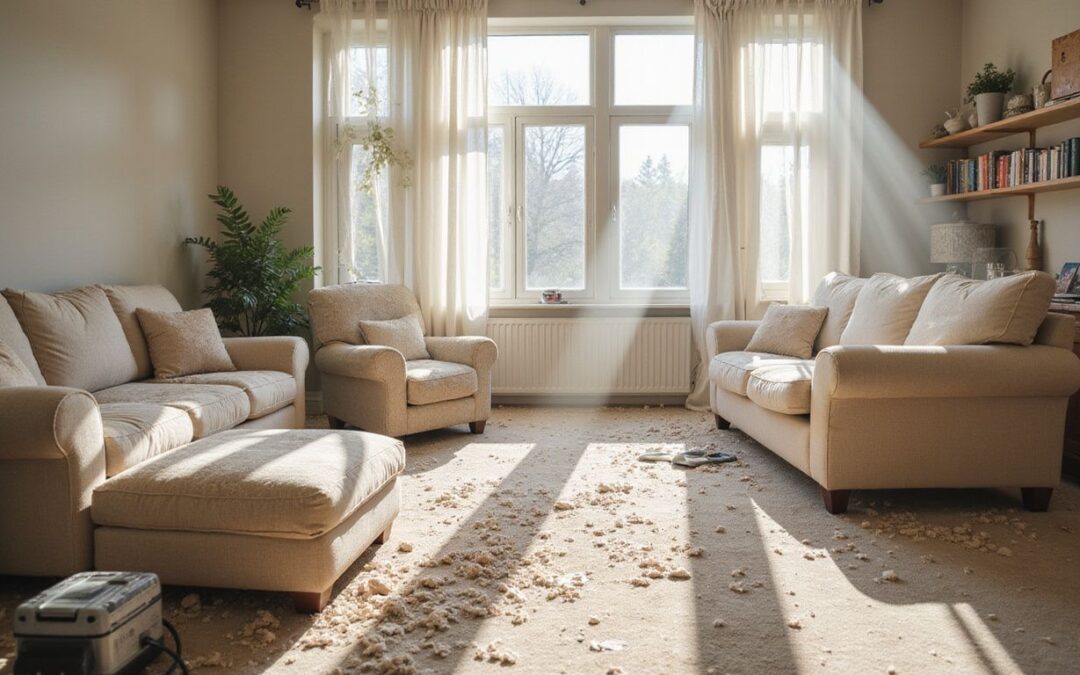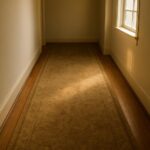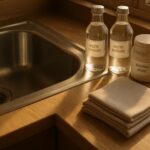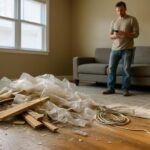Every homeowner tackling renovation projects knows the headache: construction dust gets everywhere. It sneaks into carpets, settles on furniture, and floats in indoor air for weeks after work finishes.
Breathing this fine dust can irritate lungs or trigger allergies it’s not something anyone wants around their family.
Did you know that there are three main types of construction dust homeowners deal with? Silica dust from concrete, wood dust from sanding hardwood floors or cabinets, and lower-toxicity particles like drywall powder can all linger inside homes long after renovations end. You’ll need a post-construction cleaning.
This post will explain practical steps to get rid of construction dust safely and quickly using tools like HEPA-filter vacuum cleaners, microfiber cloths, mops, and other affordable cleaning supplies everyone has access to at home.
Read on for simple solutions that make a big difference!
Quick Post-Construction Cleaning Checklist:
- Ventilate the space.
- Perform rough cleaning with a HEPA filter vacuum.
- Wipe down surfaces with damp microfiber cloths and an all-purpose cleaner.
- Clean air vents and replace filters.
- Mop floors thoroughly using a mop and bucket.
- Perform a final touch-up cleaning.
Key Takeaways
- Construction dust from materials like wood, drywall, concrete, and metal can harm your family’s health by causing breathing issues, allergies, asthma symptoms, lung diseases such as silicosis or pulmonary fibrosis or even cancer; proper cleanup with tools like HEPA-filter vacuums and microfiber cloths helps reduce these risks effectively. You need to get rid of construction dust.
- Regularly removing construction dust protects household items: fine particles quickly build up on furniture surfaces and electronics leading to scratches on finishes or blocked airflow in appliances that increase repair costs later; carefully mopping floors with damp microfiber cloths and cleaning air vents using a vacuum fitted with a HEPA filter safeguards home belongings.
- Homeowners should always wear personal protective equipment (ppe) during post-construction cleaning tasks: N95 respirators protect against breathing harmful silica or metal dust particles deep into lungs while sturdy gloves prevent skin irritation caused by cement debris or sharp splinters left after renovation projects end.
- To minimize the spread of construction dust immediately during renovations homeowners need protective plastic sheeting installed around unaffected areas along with frequent quick clean-ups; continuously running portable air purifiers featuring efficient HEPA filters also significantly improves indoor air quality for safer living spaces afterward.
- Hiring experienced professional cleaners after major home improvement projects can ensure total removal of persistent hazards like mold spores or silica-containing concrete residue; professional teams equipped with industrial-strength mop-and-bucket systems plus OSHA-compliant safety practices thoroughly clear heavy accumulations missed by standard household methods.
Why Is It Important to Remove Construction Dust?
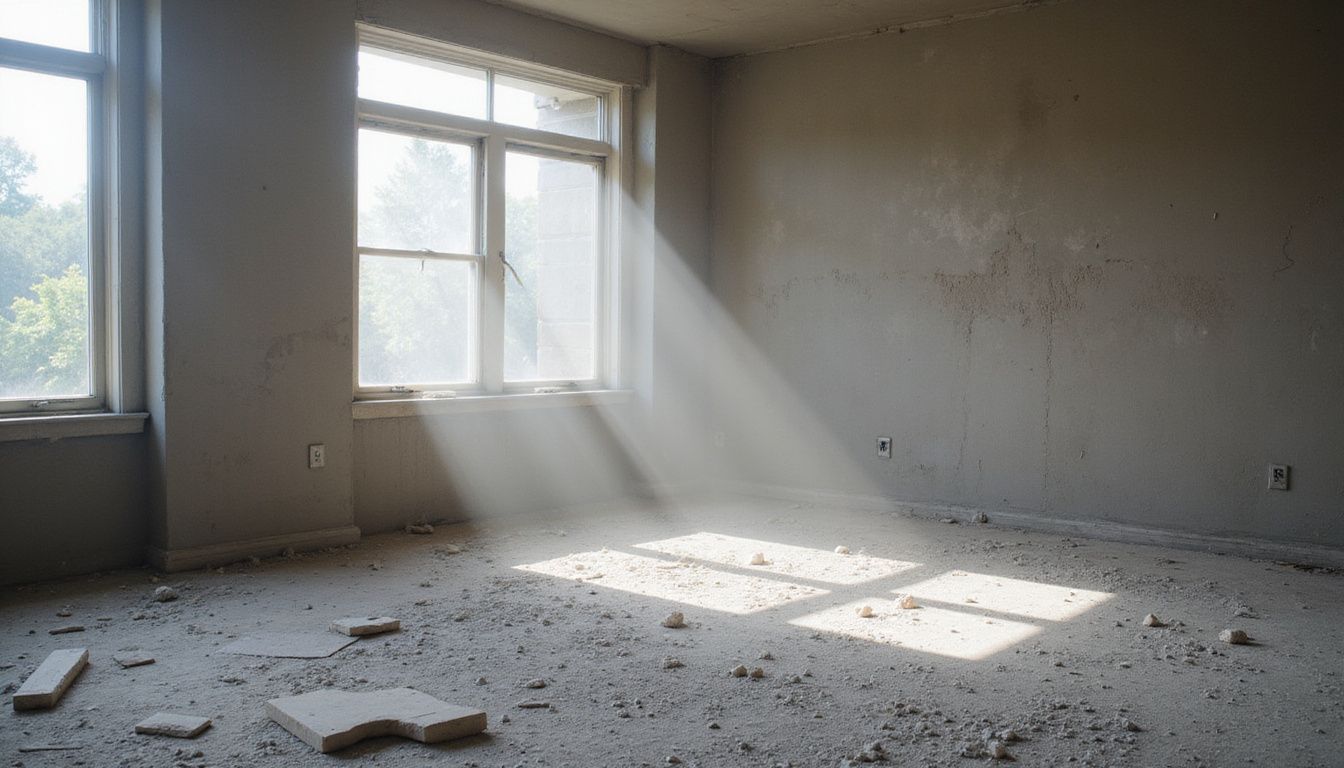
Breathing in construction dust isn’t just annoying tiny particles from wood, cement, or drywall can harm lungs and trigger respiratory problems. Ignoring dust cleanup also speeds up wear on furniture and home appliances, shortening their lifespan, so get rid of construction dust.
Health risks of construction dust
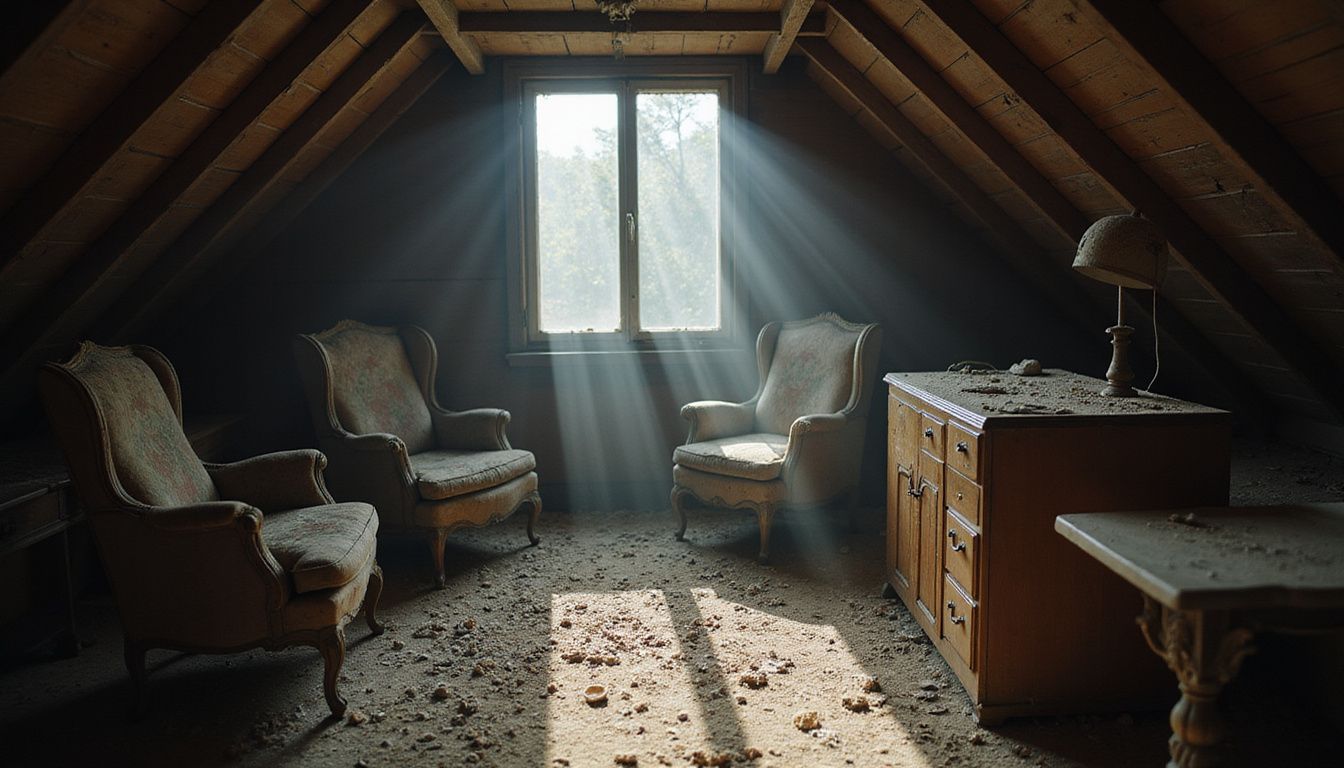
Fine dust from renovations can harm the respiratory system, especially silica dust found in concrete and sandstone. Silica particles settle deep into lung tissue and alveoli, causing chronic lung diseases like pulmonary fibrosis or even cancer.
Construction debris may also contain mold spores, asbestos fibers, volatile organic compounds (vocs), bacteria, fungi, chemicals, and heavy metals all risky for nasal mucosa and airways.
Kids at home are particularly vulnerable to these air pollutants since their lungs are still developing. Exposure to hazardous construction dusts without proper personal protective equipment (ppe) such as masks or respirators significantly increases the chance of severe health problems.
Construction particles aren’t only harmful for people they’re bad news for your home’s furniture and appliances too.
Impact on furniture and appliances
Construction dust doesn’t stop at causing breathing trouble; it also loves to settle on expensive furniture and household appliances. Dust particles from wood chips, drywall, or even concrete can sneak into every crack of sofas, tables, refrigerators, and ovens, get rid of construction dust.
Without regular cleaning during home improvement projects, these tiny invaders build up fast and cause scratches or dull finishes over time. Hardwood floors covered in fine dust lose their shine quickly if not cleaned with damp mopping using microfiber cloths and an all-purpose cleaner.
Electronics like TVs or HVAC systems draw in dust through air vents which clog filters inside the devices. Clogged air filters mean higher repair bills down the road due to poorer performance from blocked airflow causing a headache no homeowner needs after costly renovations.
Long-term air quality concerns
Leftover construction dust can stay in homes long after renovation work ends. Fine dust particles, such as silica dust from concrete and cement, wood dust, or drywall residue often hang in the air or hide inside air vents and carpets.
Breathing these tiny airborne pollutants for weeks or months affects indoor hygiene, irritates noses and lungs, and may trigger health issues like allergies or asthma symptoms among kids.
Household appliances like vacuum sweepers without HEPA filters will stir up pollutants rather than trapping them. Using an air purifier with proven clean air delivery rates (CADR) helps families manage fine particles that a mop and bucket alone can’t reach.
Common Types of Construction Dust
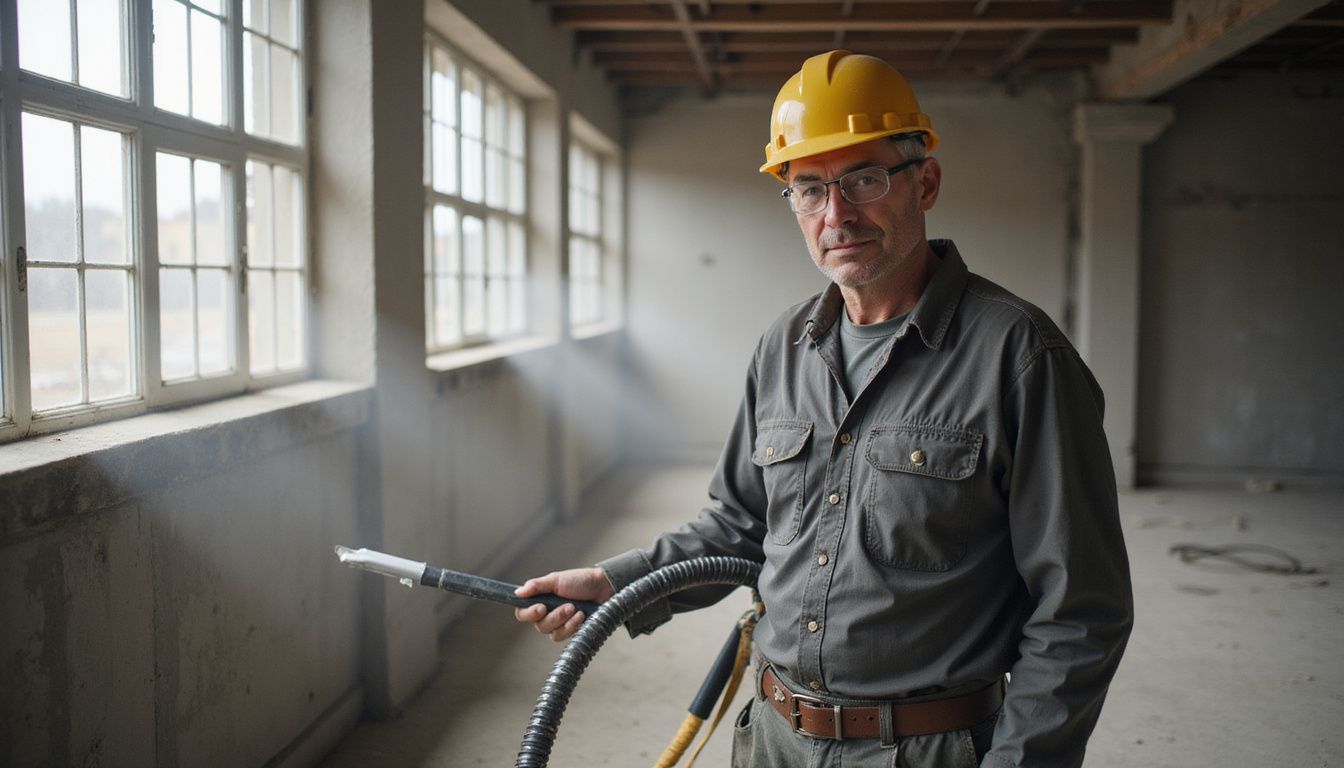
Homeowners sometimes find themselves coughing through clouds of nasty dust during renovation. Yet not all construction dust is equal some particles may put your lungs or belongings at greater risk.
Drywall and plaster dust
Drywall and plaster dust mainly come from gypsum, limestone, and similar materials. These fine dust particles quickly settle on furniture, carpets and upholstery during renovation projects, leaving behind thin layers that stick around.
Breathing them in could irritate eyes, noses, throats or even trigger asthma attacks for both adults and kids.
Using damp microfiber cloths to wipe surfaces first cuts down the spread of construction debris before finishing with industrial vacuum cleaners featuring HEPA filters for complete removal.
Wood dust
Wood dust shows up whenever lumber gets cut, sanded, or drilled during renovation projects. It spreads quickly and settles onto furniture, floors, and air vents throughout the home, so get rid of construction dust.
Breathing in these tiny dust particles can irritate lungs and throats especially for children whose respiratory systems are sensitive. Wood dust is also combustible material that could ignite from sparks or static electricity around power tools like saws or drills.
To reduce risks from wood debris at home improvement projects, homeowners need to remove it with HEPA filter vacuums like a Shop-Vac or specialized dust extractors capable of trapping fine dust safely.
Now let’s move on to concrete and cement dust during renovations.
Concrete and cement dust
Concrete and cement dust pose serious health risks during home improvement projects. These materials contain harmful silica dust, often found in concrete, sandstone, and similar items.
Inhaling fine silica dust can harm lungs and cause long-term breathing problems like silicosis. Cement dust may also have chemicals or heavy metals that irritate skin and eyes.
Metal dust
Unlike concrete and cement dust, metal dust often contains tiny heavy metal particles. Activities like cutting pipes, sanding fixtures, or welding can release harmful aluminum, magnesium, or even lead bits into the home’s air.
These dust particles pose serious health risks because they can settle deep inside a person’s lungs and cause breathing problems.
Cleanup for metal dust needs careful handling use an explosion-proof shop vac to remove combustible materials safely without causing sparks that could ignite fires at home.
Preparing for Post-Renovation Cleanup

Before get rid of construction dust, homeowners should have cleaning supplies and tools ready to go. Wearing personal protective equipment (ppe) makes cleanup safer and less stressful for everyone involved.
Gather necessary cleaning tools and supplies
Homeowners tackling post-construction cleaning need the right tools for effective dust removal. Essential items include a sturdy mop and bucket, vacuum with a HEPA filter to trap fine dust particles, broom, and dustpan.
Microfiber cloths pick up drywall or wood dust without spreading it around; paper towels help handle quick cleanups of smaller debris. Glass cleaner, an all-purpose cleaner, scrub brushes, sponges, disinfectant sprays, and dryer sheets round out helpful supplies.
Use protective gear like masks and gloves
Masks and gloves help keep construction dust out of eyes, noses, and off skin. Safety glasses or goggles protect against fine dust like silica dust or drywall particles that irritate the eyes.
Face masks labeled “N95 respirators” filter harmful airborne debris during post-construction cleaning. Durable work gloves shield hands from sharp metal scraps, rough concrete bits, and leftover wood splinters.
Wearing long-sleeved shirts, closed-toe footwear such as sturdy boots, and hard hats further prevents injuries caused by falling construction debris while mopping floors or wiping down air vents after renovation projects.
Seal off unaffected areas
Plastic sheeting is a homeowner’s best buddy during renovations. Installing it prevents construction dust and debris from invading clean areas like bedrooms, living rooms, or kitchens.
Securing sheets over doors and vents keeps fine dust particles limited to the renovation zone only. This simple action reduces the time spent on post-construction cleaning with all-purpose cleaner, microfiber cloths, mop and bucket later on and help you get rid of dust construction.
Step-by-Step Guide to Get Rid of Construction Dust
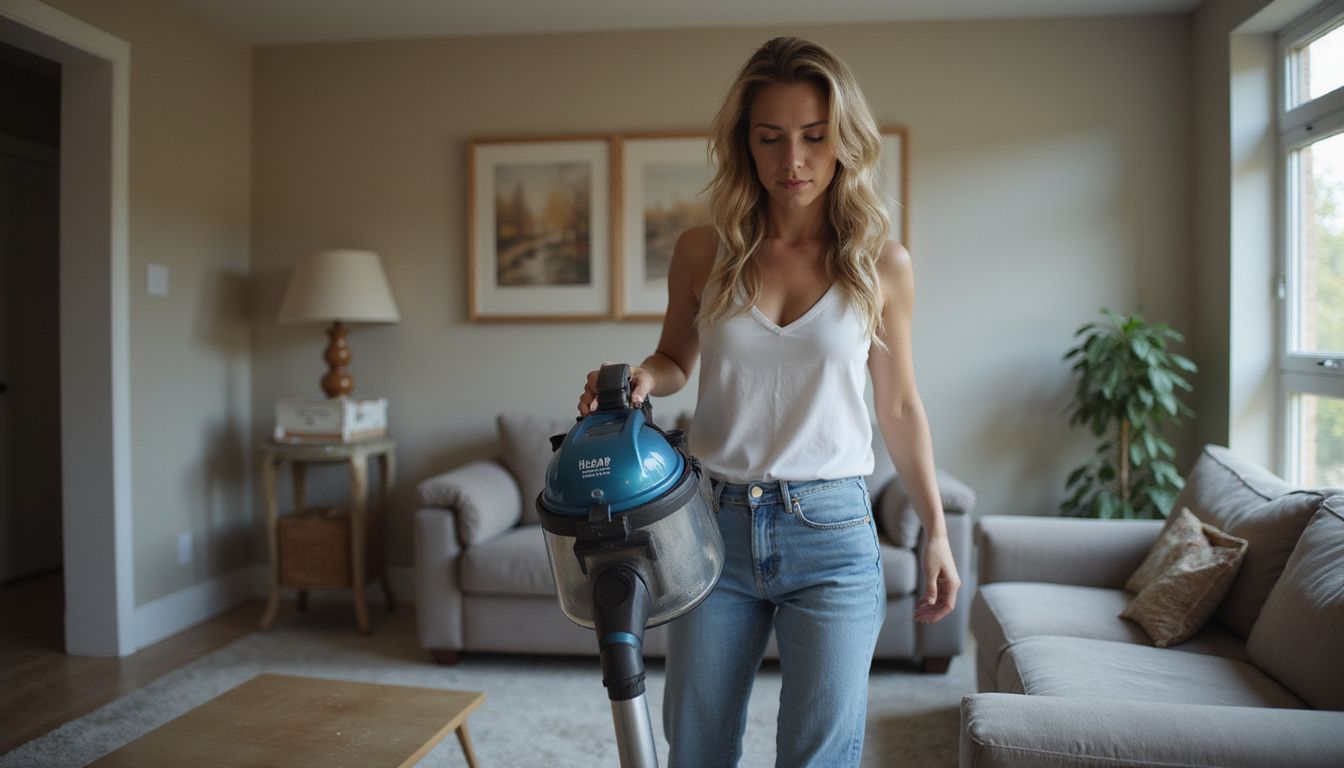
Cleaning up construction dust isn’t rocket science, but homeowners should tackle it with the right cleaning equipment like HEPA vacuums and microfiber cloths. With a solid post-construction cleaning checklist in hand, even tough dust particles won’t know what hit them.
Step 1: Ventilate the space
Fresh air helps clear dust particles and improves air quality inside the home. Homeowners can open windows on opposite sides of the room to create cross-ventilation.
A dehumidifier also cuts moisture and prevents toxic mold from growing during renovation projects.
Properly ventilated spaces reduce airborne pollutants like volatile organic compounds (vocs) often found in paints or cleaning products used during renovations. Installing range hoods over stoves removes welding fumes or other irritants that form while fixing kitchens.
Using portable air cleaners fitted with HEPA filters actively traps tiny debris suspended in indoor air, creating a safer post-construction environment for everyone at home.
Step 2: Conduct a rough cleaning with a HEPA vacuum
Homeowners can start the cleanup with a HEPA filter vacuum to remove fine dust particles left from construction debris. A rough cleaning targets drywall, wood dust, silica dust, cement and metal particles collected on floors, carpets and upholstery.
Using a high-powered vacuum cleaner helps capture tiny airborne contaminants that regular vacuums often miss.
Step 3: Wipe down all surfaces with damp cloths
After handling dust removal with a HEPA vacuum, the next move is using microfiber cloths for damp wiping. Microfiber cloths trap fine dust particles better than regular rags and help avoid spreading construction debris around.
Using a mild all-purpose cleaner mixed in water aids thorough cleaning without damaging furniture or surfaces.
Damp mopping tabletops, doors, window sills, cabinets, sinks, hardwood floors and walls removes stubborn wood dust or drywall powder that might have stuck during renovation.
Regularly rinsing out the cloth ensures clean swipes every time for improved air quality at home after extensive home improvement projects.
Step 4: Clean air vents and replace air filters
Dirty air vents cause more than sneezing fits; they spread construction dust right into each room of the house. Washing vent covers in warm, soapy water removes trapped fine dust and debris before it circulates again.
Replacing old, clogged air filters with fresh ones fitted with HEPA filters helps catch tiny particles like wood dust or drywall fragments. Clean air filters protect family health by cutting down allergens that irritate eyes, noses, or lungs.
Homeowners who regularly replace these parts will breathe easier since cleaner ventilation reduces overall indoor air pollution from renovation projects.
Step 5: Mop floors thoroughly
Mopping floors thoroughly clears out fine dust that settles after renovations. Using a damp mop with the right cleaning supplies helps trap and remove even stubborn construction debris.
For hardwood, tile, or laminate surfaces, pick an appropriate all-purpose cleaner made specifically for those floor types to avoid damage. Microfiber cloths wrapped around a mop head work wonders in catching leftover dust particles on hard-to-reach corners and edges.
A bucket filled with warm water and suitable cleaning solutions is necessary for effective damp mopping of larger spaces. Homeowners can clean section by section, rinsing often to prevent spreading dirty mixtures across cleaned areas.
Choosing products designed for individual floor materials protects finishes while leaving indoor environments free from harmful silica dust or unwanted allergens like mold spores and volatile organic compounds (vocs).
Step 6: Perform a final touch-up clean
After thoroughly mopping, the homeowner should perform a final touch-up clean to remove any leftover construction dust or debris that escaped earlier sweeps. A damp microfiber cloth helps target fine dust particles hiding on surfaces like shelves, window ledges, and baseboards.
Using an all-purpose cleaner mixed in a mop and bucket solution will tackle tough areas missed during initial cleaning tasks. Doing quick checks around furniture pieces, appliances, air vents, switches, and doorknobs confirms each area is spotless for family use again.
These minor cleaning tasks guarantee high indoor air quality after renovation projects end.
Case Study Insight: A local homeowner followed a post-construction cleaning checklist after home improvement projects. She used a HEPA filter vacuum for rough cleaning and practiced damp mopping with microfiber cloths. This method significantly reduced dust particles and improved indoor air quality.
Cleaning Construction Dust from Specific Areas
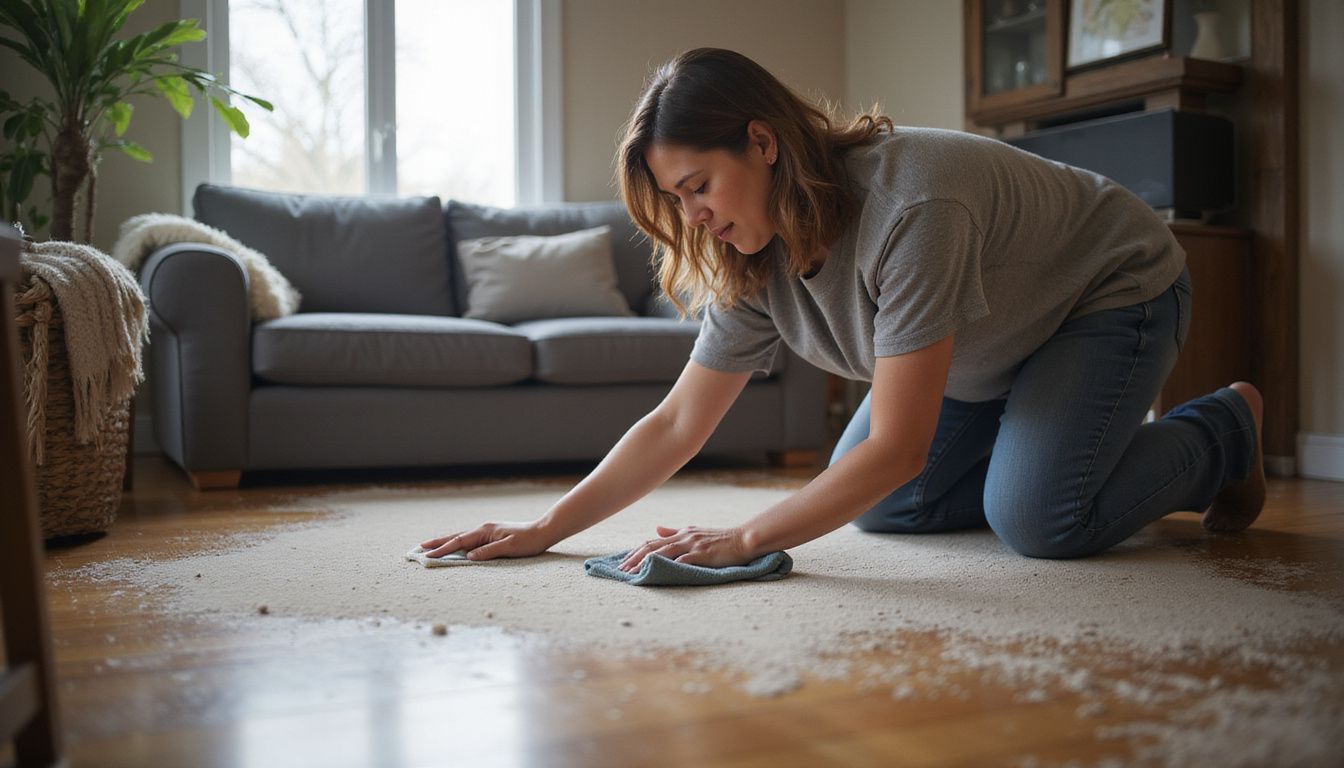
Cleaning dust from tricky spots like hardwood floors or upholstery can feel like herding cats, but with the right mop and bucket, microfiber cloths, and HEPA vacuum in hand it’s simpler than homeowners might think; read on for helpful tips.
Hardwood floors
Hardwood floors look great but can trap fine dust particles easily. To remove construction dust, homeowners should mop the surface using warm water mixed with a natural wood cleaner instead of an all-purpose cleaner to protect the finish.
Mop in horizontal strokes and rinse regularly; damp mopping this way grabs leftover wood dust without leaving streaks or harming delicate surfaces. A final wipe-down with microfiber cloths gives hardwood back its original shine after home improvement projects wrap up.
Walls and ceilings
Walls and ceilings trap huge amounts of construction dust. A good way to clean ceilings is by using a long-handled mop with horizontal strokes, making damp mopping less tiring on the arms.
For walls, plain soapy water cleans best when used with microfiber cloths or soft-bristled brushes to remove fine dust without scratching paintwork.
Homeowners should also keep buckets, sponges, all-purpose cleaner, and necessary cleaning supplies handy during post-construction cleaning tasks for quicker progress room by room.
Carpets and upholstery
Carpets and upholstery easily trap fine dust particles during a home improvement project. A HEPA filter vacuum is ideal for cleaning cushions, sofas, curtains, and rugs after renovations end.
Damp mopping or wiping these soft surfaces with microfiber cloths removes leftover construction debris effectively. Regular vacuuming prevents wood dust and silica dust from getting stuck deep within carpet fibers or fabric sofas.
Taking time to thoroughly remove construction dust protects family health by reducing risks of allergies or breathing in harmful substances like volatile organic compounds (vocs).
Tips for Minimizing Construction Dust During Renovation
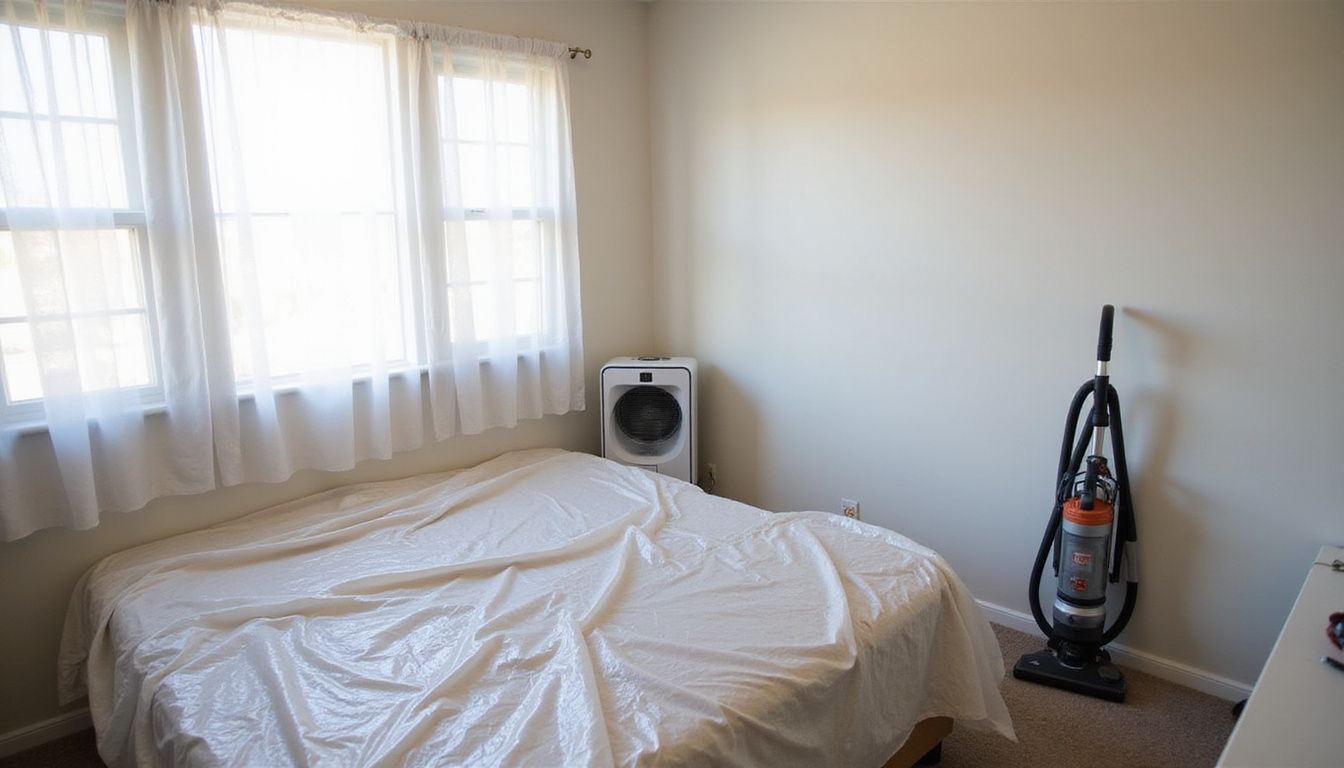
Limiting construction dust isn’t rocket science smart prep and practical actions go far to keep your home breathable. With some plastic sheeting, air purifiers, and quick clean-ups during the project, you can dodge days of tiresome cleaning ahead.
Use plastic sheeting to contain dust
Plastic sheeting helps homeowners control construction dust during home improvement projects. Clear plastic barriers seal off areas under renovation and prevent fine dust particles from spreading to other rooms.
Secure the edges of sheeting with tape to block gaps tightly, keeping hardwood floors, carpets and upholstery safe from harmful wood dust or silica dust. Sheeting also protects furniture, appliances and air vents inside clean spaces that should remain free of construction debris.
Employ air purifiers with HEPA filters
Air purifiers with HEPA filters capture fine dust during home improvement projects. These devices remove up to 99.97% of tiny airborne dust particles, including harmful silica dust and wood dust, helping you get rid of construction dust.
Placing air purification systems in high-traffic areas cuts down on construction debris spreading through homes. Families benefit from improved indoor air quality and fewer health risks related to inhaled contaminants like toxic mold spores or allergens.
Air purifiers can run day and night during renovations for effective ongoing dust removal, creating safer spaces for parents, children, and pets alike.
Regularly cleaning as the renovation unfolds helps homeowners keep ahead of accumulating messes—here are some helpful tips about staying tidy while work progresses.
Regularly clean during the renovation process
While air purifiers with HEPA filters catch dust particles floating around, regular cleaning tackles the buildup on surfaces. A quick daily cleanup using a mop and bucket or microfiber cloths helps lower overall dust accumulation throughout any home improvement project.
Damp mopping floors and wiping down furniture reduces construction debris piling up over time. Frequent cleaning also simplifies final post-construction cleaning tasks, sparing homeowners from hours of scrubbing fine wood dust or drywall residue at renovation’s end.
When to Hire Professional Cleaning Services
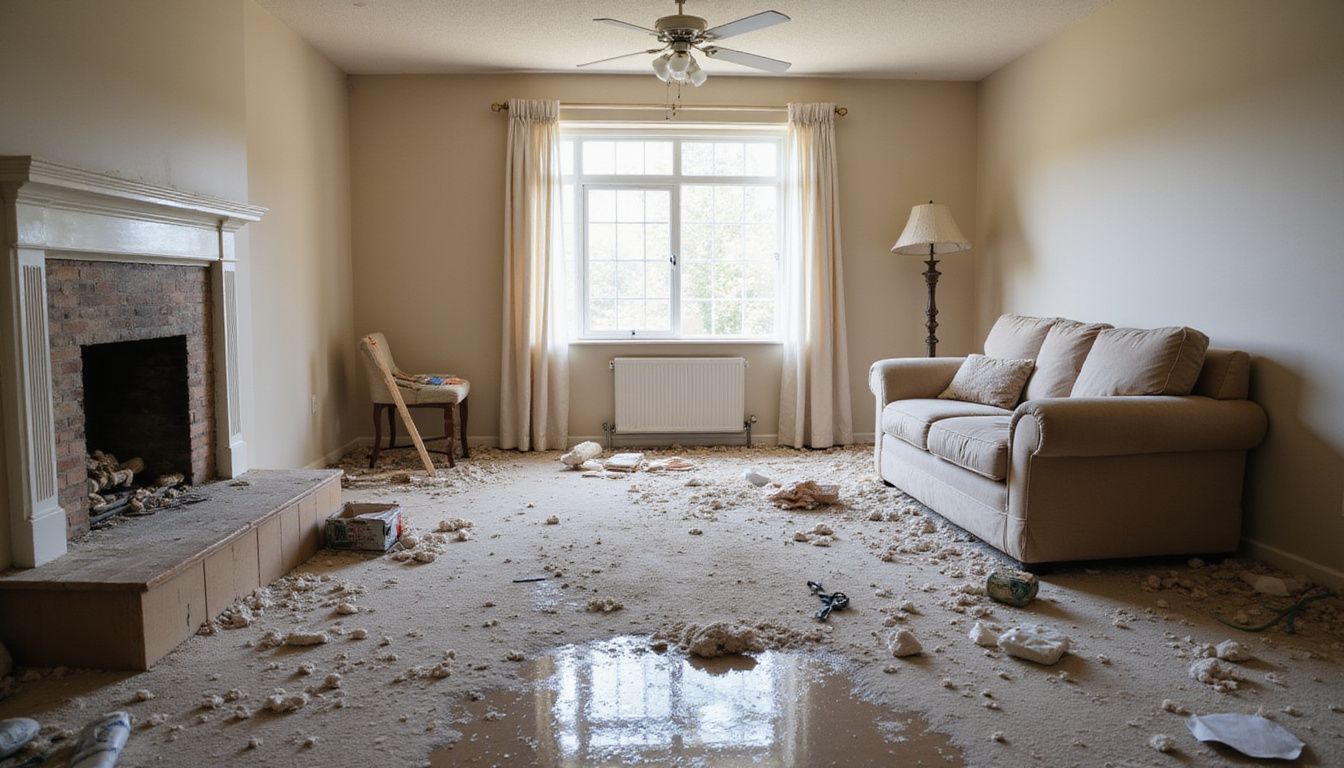
If the house feels buried in construction debris, calling a trusted cleaning service can save your sanity. With floor scrubbers and industrial-strength vacuums, they’ll quickly make dust particles vanish.
Benefits of professional post-construction cleaning
Professional post-construction cleaning teams bring more than a mop and bucket to the job. Bonded, insured, OSHA-compliant crews use specialized cleaning equipment like HEPA filter vacuums and floor scrubbers to tackle fine dust and construction debris effectively.
These experts follow an organized post-construction cleaning checklist so every surface from hardwood floors and carpets to air vents gets careful attention.
Families breathe easy with professional cleaners handling toxic mold spores, silica dust or volatile organic compounds (vocs). Crews wear personal protective equipment (ppe) including masks and gloves for safety as they remove harmful contaminants thoroughly.
Hiring a trusted cleaning service also frees busy parents from hours of damp mopping walls or wiping down furniture with microfiber cloths after tiring home improvement projects.
How to choose a reliable cleaning service
Homeowners must find a trusted cleaning service that is bonded, insured, and OSHA-compliant to handle post-construction cleaning safely. Checking online reviews and getting referrals from friends helps verify quality.
Reliable services provide clear post-construction cleaning checklists outlining the exact tasks they will do. Homeowners should pick businesses offering specific plans that fit their needs rather than standard packages.
An honest company willingly shows proof of insurance coverage and employee safety training with personal protective equipment (ppe).
Conclusion
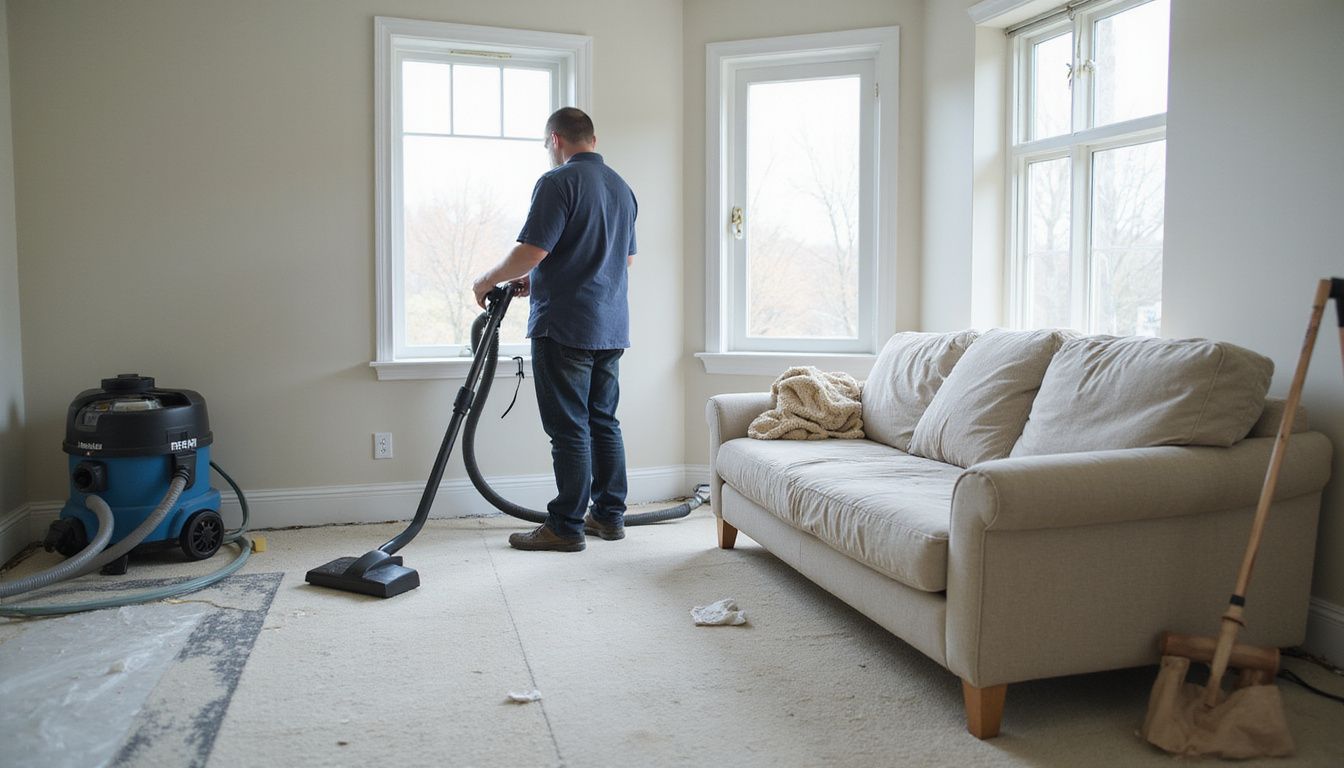
Removing construction dust protects health and keeps furniture clean after renovation. Using proper tools like a HEPA vacuum, microfiber cloths, mop and bucket saves time during cleanup.
Careful sealing with plastic sheeting cuts airborne particles while cleaning air vents boosts overall air quality. Hiring trusted cleaning services can handle heavy debris or persistent silica dust safely.
Simple steps from ventilating rooms to damp mopping floors support easy removal of fine dust in every home renovation project. Tackling construction mess early brings cleaner air, healthier family members, and leaves living spaces fresh enough to welcome friends again comfortably.
FAQs
1. What’s the best way to remove construction dust after home improvement projects?
Start by ventilating your space and using cleaning supplies like microfiber cloths for effective dust removal. Damp mopping with an all-purpose cleaner also helps trap fine dust particles quickly.
2. Is personal protective equipment (ppe) needed when dealing with wood dust or silica dust?
Absolutely, ppe is essential whenever you handle harmful materials such as wood dust, silica dust, asbestos fibres, toxic mold or volatile organic compounds (vocs). Always perform a risk assessment under Control of Substances Hazardous to Health (COSHH) guidelines before starting cleanup.
3. How do I clean air vents clogged with construction debris and fine dust?
Use a vacuum fitted with a HEPA filter attachment to suck out stubborn construction debris from air vents effectively. Follow up by wiping surfaces gently using damp microfiber cloths.
4. Can regular cleaning equipment tackle post-construction cleaning tasks properly?
Regular tools like mop and bucket are helpful but may not fully capture tiny alveolar-level particles in heavy-duty situations involving silica or asbestos fibres. Hiring a trusted cleaning service experienced in post-construction cleaning ensures thorough results without hassle.
5. What should be included on my post-construction cleaning checklist for safe cleanup practices?
Your checklist must cover proper ventilation methods, correct use of ppe gear during cleanup activities, careful handling of hazardous substances according to COSHH standards plus detailed steps for removing leftover construction debris safely from every corner.
6. Are there health risks if I don’t promptly deal with leftover construction dust at home?
Yes indeed ignoring lingering fine particles can lead directly into respiratory issues caused by inhaling harmful substances including toxic mold spores or VOC fumes over time; prompt action protects everyone’s lungs!
Disclosure: This content is informational and not a substitute for professional advice. Please consult appropriate experts for post-construction cleaning, health issues, or safety concerns. No affiliate relationships are involved. Source information is accurate as of publication.

